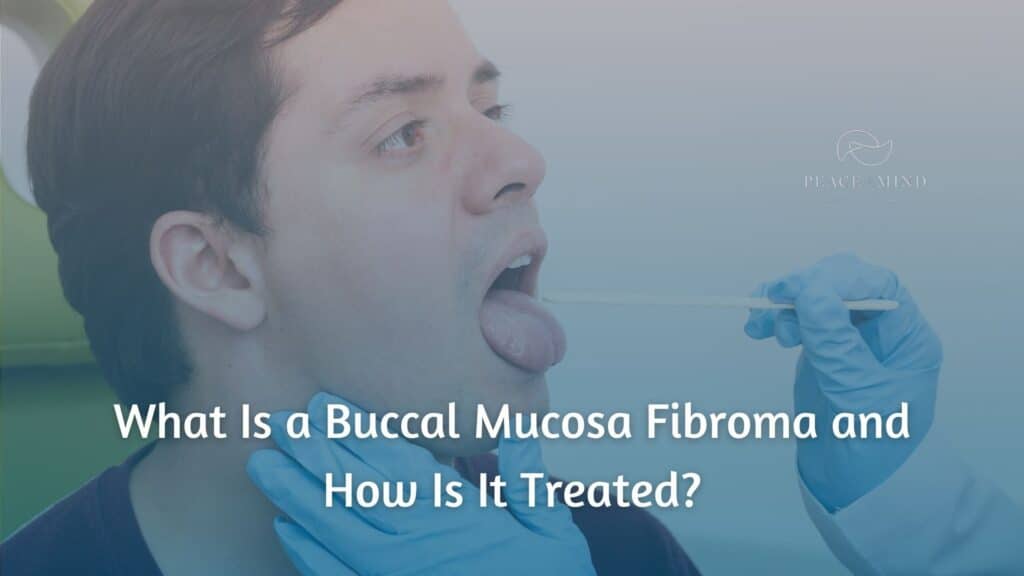
Your mouth is a reflection of your overall health. Thus, if you notice anything unusual, you should consult a dentist. One such issue is the pale bump inside your mouth. It is called an oral fibroma. Although it is not a cause for concern, it can become uncomfortable or interfere with daily activities such as talking or chewing.
Thus, it’s crucial to understand the buccal mucosa fibroma, its reasons, diagnosis, and treatment options. This blog has discussed the oral fibroma in detail. Read on!
What is Buccal Mucosa Fibroma?
A buccal mucosa fibroma is a benign growth in your mouth that usually appears on the inner lining of the cheek. It is one of the most common types of oral fibromas, which can pose challenges due to continuous irritation.
What Causes a Buccal Mucosa Fibroma?
Oral fibroma is often caused by:
- Cheek or lip biting
- Friction from rough teeth or dental appliances like braces or dentures
- Poorly fitted crowns or fillings
- Habits such as tongue thrusting or nail biting
The growth appears as a result of trauma over time. A fibrous lump develops to protect the tissue, and you might injure it unintentionally, making it painful.
Symptoms of a Fibroma in the Mouth
An oral fibroma looks like a small, round or oval lump. It can be pale, flesh-colored, or darker than the surrounding tissue. It is smooth and firm to the touch, but usually painless.
They are benign and go away on their own, but if you frequently bite down on them or they are constantly rubbed against teeth or dental appliances, they can become sore and ulcerated.
Is a Buccal Mucosa Fibroma Cancerous?
No, it is a benign tissue growth and not cancerous at all. However, sometimes it is difficult to diagnose whether the lump in your mouth is an oral fibroma or something else. Thus, you must consult us at Peace of Mind Dental Studio for evaluation. In some cases, similar-looking lesions may be confused with oral fibroma cancer, which is why professional diagnosis is essential.
Diagnosis: How Is a Dental Fibroma Identified?
Dentists can identify the fibroma by touching it. In some cases, a biopsy is recommended if the growth has unusual characteristics. The biopsy confirms that the tissue is benign and helps differentiate a fibroma from other types of oral lesions.
Oral Fibroma Treatment Options
If the oral fibroma doesn’t go away on its own, and grows bothersome, treatment is essential. Here are some treatment options for treating dental fibroma:
Observation: If the fibroma is small and not causing discomfort, it is monitored.
Surgical Removal: Do not be alarmed by the word “surgical.” It is usually a quick and painless procedure that takes no time at all.
Laser Excision: Laser removal is another option for a quicker recovery and less bleeding.
How Is a Fibroma in the Mouth Removed?
In cases of hard, long-lasting bumpy growth that poses daily life challenges, oral fibroma removal is recommended. This is an in-office procedure, wherein we numb the location with local anesthesia. The growth is excised, sometimes with a laser. It takes less than 30 minutes, depending on the size and location of the fibroma.
Recovery of an oral fibroma is usually smooth and can be managed with over-the-counter medications. Stitches may be used, and we will provide aftercare instructions.
What Is the Cost of Oral Fibroma Removal?
Oral fibroma removal cost varies depending on many factors such as size and complexity of the fibroma, the type of removal you opted for, and whether any biopsy was performed. In some cases, insurance also covers the procedure cost, thus reducing the out of pocket expenses.
The average cost of oral fibroma removal is $150-$500.
What Happens After Oral Fibroma Removal?
Depending upon the size of the fibroma, it might take 1-2 weeks to heal. To speed up healing, do the following:
- Avoid spicy or acidic foods
- Rinse gently with salt water
- Brush carefully around the surgical site
We schedule a follow-up appointment for you to ensure that you are comfortable and the growth hasn’t resumed.
Preventing Recurrence of Buccal Mucosa Fibroma
- Treating repetitive buccal mucosa fibroma through the current procedure is not viable. Hence, it is crucial to focus on addressing the underlying causes, such as:Smooth rough teeth or adjust dental appliances
- Discuss behavioral changes to avoid trauma (like cheek chewing)
- Recommend protective gear, like mouthguards, for nighttime grinding
Good oral hygiene and routine dental checkups help detect any new issues early on. So, book an examination with us at Peace of Mind Dental Studio.
Conclusion
Generally, a buccal mucosa fibroma is benign, but it is advised to get it evaluated. If you are in pain or feel discomfort, you must get prompt treatment.
Book an appointment with us, so we can evaluate it properly and treat it to remove future complications.
Say goodbye to oral discomfort with Peace of Mind Dental Studio!
Frequently Asked Questions
Que: Is buccal mucosa fibroma painful?
Ans: No, an oral fibroma is usually painless, but it may become sore due to trauma and continuous irritation.
Que: Can a dental fibroma go away on its own?
Ans: Yes, it usually goes away on its own, but if it doesn’t, professional intervention becomes necessary.
Que: How long does oral fibroma removal take?
Ans: The procedure takes only 15-30 minutes.
Que: Is oral fibroma cancerous?
Ans: No, it is benign, but a biopsy is required in some cases to confirm.
Que: What is the oral fibroma removal cost?Ans: The average oral fibroma removal cost in Chandler is $150-$500.


